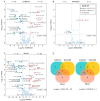Lipidomic Characterization of Oocytes at Single-Cell Level Using Nanoflow Chromatography-Trapped Ion Mobility Spectrometry-Mass Spectrometry
- PMID: 37241942
- PMCID: PMC10221703
- DOI: 10.3390/molecules28104202
Lipidomic Characterization of Oocytes at Single-Cell Level Using Nanoflow Chromatography-Trapped Ion Mobility Spectrometry-Mass Spectrometry
Abstract
Mass spectrometry (MS)-based lipidomic has become a powerful tool for studying lipids in biological systems. However, lipidome analysis at the single-cell level remains a challenge. Here, we report a highly sensitive lipidomic workflow based on nanoflow liquid chromatography and trapped ion mobility spectrometry (TIMS)-MS. This approach enables the high-coverage identification of lipidome landscape at the single-oocyte level. By using the proposed method, comprehensive lipid changes in porcine oocytes during their maturation were revealed. The results provide valuable insights into the structural changes of lipid molecules during porcine oocyte maturation, highlighting the significance of sphingolipids and glycerophospholipids. This study offers a new approach to the single-cell lipidomic.
Keywords: lipidomic; liquid chromatography; mass spectrometry; oocytes; single-cell.
Conflict of interest statement
The authors declare no conflict of interest.
Figures




Similar articles
-
Trapped ion mobility spectrometry and PASEF enable in-depth lipidomics from minimal sample amounts.Nat Commun. 2020 Jan 16;11(1):331. doi: 10.1038/s41467-019-14044-x. Nat Commun. 2020. PMID: 31949144 Free PMC article.
-
Single Cell Untargeted Lipidomics Using Liquid Chromatography Ion Mobility-Mass Spectrometry.J Proteome Res. 2025 Apr 4;24(4):1579-1585. doi: 10.1021/acs.jproteome.4c00658. Epub 2025 Feb 14. J Proteome Res. 2025. PMID: 39950635
-
Lipidomics by HILIC-Ion Mobility-Mass Spectrometry.Methods Mol Biol. 2020;2084:119-132. doi: 10.1007/978-1-0716-0030-6_7. Methods Mol Biol. 2020. PMID: 31729657 Free PMC article.
-
Utilizing Skyline to analyze lipidomics data containing liquid chromatography, ion mobility spectrometry and mass spectrometry dimensions.Nat Protoc. 2022 Nov;17(11):2415-2430. doi: 10.1038/s41596-022-00714-6. Epub 2022 Jul 13. Nat Protoc. 2022. PMID: 35831612 Free PMC article. Review.
-
Chemical derivatization strategy for mass spectrometry-based lipidomics.Mass Spectrom Rev. 2023 Jan;42(1):432-452. doi: 10.1002/mas.21729. Epub 2021 Sep 5. Mass Spectrom Rev. 2023. PMID: 34486155 Review.
Cited by
-
Evaluation of Lipid Changes During the Drying Process of Cordyceps sinensis by Ultra Performance Liquid Chromatography-Tandem Mass Spectrometry (UPLC-MS/MS)-Based Lipidomics Technique.J Fungi (Basel). 2024 Dec 11;10(12):855. doi: 10.3390/jof10120855. J Fungi (Basel). 2024. PMID: 39728352 Free PMC article.
-
Recent Analytical Methodologies in Lipid Analysis.Int J Mol Sci. 2024 Feb 13;25(4):2249. doi: 10.3390/ijms25042249. Int J Mol Sci. 2024. PMID: 38396926 Free PMC article. Review.
References
-
- Xie P., Zhang J., Wu P., Wu Y., Hong Y., Wang J., Cai Z. Multicellular tumor spheroids bridge the gap between two-dimensional cancer cells and solid tumors: The role of lipid metabolism and distribution. Chin. Chem. Lett. 2023;34:107349. doi: 10.1016/j.cclet.2022.03.072. - DOI
-
- Murphy R.C. Tandem Mass Spectrometry of Lipids: Molecular Analysis of Complex Lipids. 1st ed. Volume 4 Royal Society of Chemistry; Cambridge, UK: 2014.
MeSH terms
Substances
Grants and funding
LinkOut - more resources
Full Text Sources

